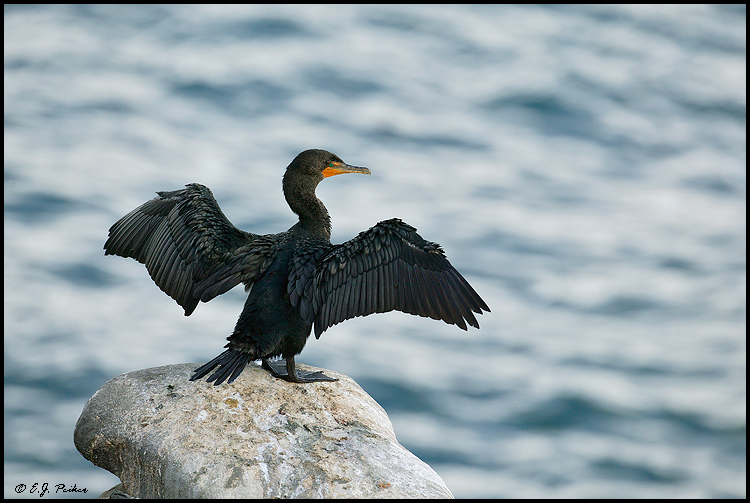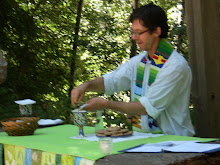Last week I told a story about my sophomore year in college,
a time in my life when I was haunted by the dread of nuclear apocalypse, and about
a confrontation I had at the time with a man whose job it was to plan nuclear
war. This week I’m remembering something
that happened about six months after that.
It was the summer, and I was on a three-week expedition at the Hurricane
Island Outward Bound School in Maine. I
was on a thirty-foot sailboat with about ten other teenagers and a couple of
adults, and we were cruising from island to island in the coastal wilderness of
Penobscot Bay.
One afternoon we were out of the sight of land, sailing by
dead reckoning in a light rain and fog.
There were some rocks on the chart with a bell buoy that we found right
where we thought they’d be, and as we left them astern I looked back. Rays of light were breaking through the low
clouds, shining on the sea in the distance, and three or four black cormorants,
what the Mainers call “shags,” were standing on the rocks holding their wings
outstretched for the feathers to dry.
Something about the sight of those birds spoke to me, as they stood out
there in the middle of that cold ocean, just doing what naturally needed to be
done. They spoke to me of the great life
that moves through all things, of its indestructibility and its powers of
rebirth. I felt a sense of trust and
peace, and I knew that no nuclear war or any other human evil could destroy
that life, or thwart its sheer desire to become. We could do it great harm, and ourselves
along with it, but we could not kill it forever.
Last week we also heard another story, the end of another
retelling of the tale of Jesus Christ.
He stood before the man who would shortly condemn him to death and bore
witness to the truth, as he had come into the world to do. And we bore witness to him, saying prayers
and singing hymns that acknowledged Jesus as the abiding truth about what
really matters in the world. We
acclaimed him as the world’s true ruler.
And with that we came to the end.
We turned the page on another year, as the church reckons years.
So it is strange to say, here we are again. Two weeks ago, we were in Mark’s gospel with
Jesus looking out from the Mount of Olives at the great Temple of Israel’s God,
and he prophesied its destruction, and his disciples asked about the end of the
world. Today we begin the new year, and open
Luke’s gospel, and Jesus is in Jerusalem, in the Temple, speaking about the end
of the world. So why are we still
here? Why pick up again where we just left
off? Why begin at the end?
Well, maybe because we are still waiting. We may know that Christ is the king, the true
ruler of the world. We may know that
love is the almighty power that orders all things, that was before the
beginning and will be at the end. We may
know it, I should say, by faith. But that
faith can seem pretty tenuous when we look around at the state of things. It’s hard to see the cycles of violence and
retribution in the Congo and the Middle-East, and say that love is the supreme
law. It’s hard to look at the greed and
exploitation by which the rich get richer, and the poor get poorer, and the earth
gets thrown further and further out of whack, and see how Jesus Christ is the ruler
of this world. And so, even though we have heard the good
news, the question still hangs in the air, “How long? How long will this go on?”
That question is at the heart of the Hebrew Bible. And the message of the Hebrew prophets about the
evil in the world and the unmerited sufferings of the innocent is that it will
not continue indefinitely. God will act. A day will
come, a great and awesome day, when God will re-assert sovereignty over
creation and the whole world will see what now only the prophet can. Because the judgment that takes place on that
day will not just apply to this or that person’s immortal soul. It will be a great cosmic upheaval, God’s
housecleaning, in which the whole world will be transformed.
Over centuries of exile and oppression, the Jews developed the
promise of a coming cosmic judgment into a literary form we call “apocalyptic,”
from a Greek word that means “the lifting of the veil.” Today’s gospel text from Luke begins with language
drawn from that apocalyptic tradition.
Speaking of the coming judgment, Jesus says “there will be signs in the
sun, the moon, and the stars.” On earth,
people will faint from fear, “for the powers of the heavens will be shaken.” He goes on to quote one of the most famous
passages of apocalyptic in the Bible, the Seventh Chapter of the Book of
Daniel, when he says “they will see 'the Son of Man coming in a cloud' with
power and great glory.”
But from there Jesus’ speech takes an unexpected turn. From the oracle of apocalypse, he suddenly
becomes again the teacher who sat by the Sea in Galilee, speaking simple
parables of the kingdom of God. The
imagery that he uses now also resonates deeply with the scriptures, but with a
far older stratum of the tradition. He
says, “Look at the fig tree, and all the trees,” and suddenly we are not at the
end of the world, but at its beginning.
We are in the garden that God planted with every kind of tree that was
good for food, and gave to our first parents for a dwelling. “As soon as they sprout leaves,” says Jesus, “you
can see for yourselves and know that summer is already near. When you see these things taking place, you
know that the kingdom of God is near.”
“The kingdom of God is near”—this is the essential
proclamation of the Gospel, the place where all the teaching of Jesus and the
teaching about Jesus begins. This is not
just the threat of imminent destruction but also the promise of justice and liberation
that are intimately present, intimately real.
And the signs of the kingdom are the miraculous life of ordinary things:
of a sower who goes out to sow; of a woman mixing yeast into the dough, and a net
full of every kind of fish. While the
nations fall into terror and confusion at the unraveling of the world, Jesus says
“look—it’s almost summer.”
I’m going to say that it’s not a mistake that these two
sayings are together--the apocalyptic vision and the parable of the fig tree. The
conjunction suggests that this is where we are meant to live—in this balance
point where the end and the beginning meet, this precarious place of freedom
called “now.” That is why Jesus so strongly
recommends watchfulness—staying awake and alert. Because in the presence of Jesus people
experience the justice, and the truth, and the repentance and forgiveness that
are supposed to be unveiled at the end, only it is happening now. They know the freedom, and the innocence, and
the intimacy with God that were there at the beginning, only now. And yet there are so many times we meet Jesus
and we don’t see what is happening. Our
hearts and our minds are closed and we miss it.
And I suppose that’s why we no sooner finish telling the Gospel
story than we start all over again. Because
missed something the last time around. We
are still waiting for God to do something.
We are still asleep, as if Jesus never came, as if the troubles in the
world still have no solution, as if we still don’t know what to do. So we start the story over again from the
beginning. And we do it with a sense of
hope and expectation. We hope that this
time we really will hear it, that this time it will wake us up, and Jesus
Christ will not be someone who died a long time ago, or someone who will come
someday, who knows when, but that the Son of Man will come and stand before us,
and live with us, and work through us.
Now.


No comments:
Post a Comment